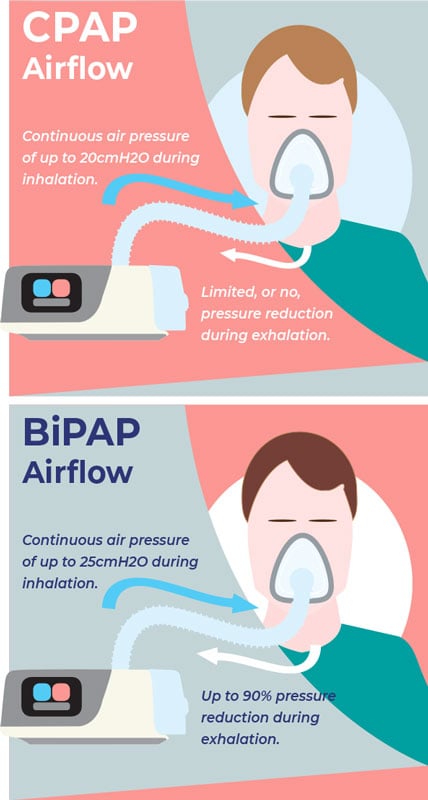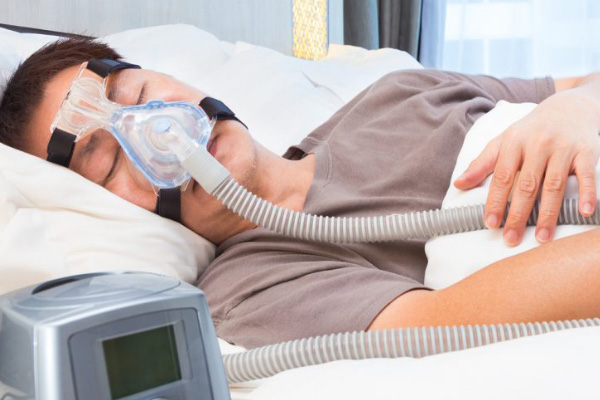Bipap vs. CPAP: Which Is the most effective for Your Sleep Condition?
When navigating the intricacies of sleep problems, the selection in between BiPAP and CPAP therapy is a vital consideration. While CPAP supplies a steady airflow suitable for obstructive rest apnea, BiPAP's twin stress settings may enhance convenience for those with more intricate respiratory concerns.
Comprehending Sleep Disorders
Sleep disorders encompass a variety of conditions that interfere with regular sleep patterns, affecting both the top quality and period of remainder. These disorders can show up in various forms, consisting of insomnia, rest apnea, narcolepsy, uneasy leg syndrome, and parasomnias. Each problem provides distinct obstacles, typically causing considerable daytime fatigue, cognitive problems, and emotional disruptions.
Sleep problems is identified by difficulty falling or remaining asleep, while rest apnea involves repeated disturbances in breathing throughout rest, usually resulting in fragmented rest. Narcolepsy, on the other hand, is marked by extreme daytime sleepiness and abrupt rest assaults. Restless leg disorder triggers uncomfortable feelings in the legs, triggering an irrepressible urge to relocate them, which can likewise impede the capacity to drop off to sleep.
The influence of rest disorders prolongs beyond individual health, influencing general efficiency, partnerships, and lifestyle. Understanding the certain nature of each problem is critical for efficient diagnosis and treatment. As rest health and wellness becomes significantly recognized as a crucial part of general well-being, resolving these problems is crucial for boosting both sleep quality and daily functioning.
Exactly How CPAP Functions
Continuous Favorable Airway Stress (CPAP) treatment is often utilized as a main therapy for obstructive rest apnea (OSA) The system of CPAP includes using a machine that provides a stable stream of air through a mask put on throughout rest. This airflow maintains favorable stress in the airway, stopping the collapse or blockage of the throat that can take place during rest.
When a patient inhales, the CPAP maker provides a constant flow of air, making certain that the air passage stays open - BiPAP Rental. This not just alleviates the signs of OSA, such as snoring and disrupted rest patterns, but likewise decreases the associated health threats, including cardiovascular difficulties and daytime exhaustion
The pressure settings on a CPAP maker can be tailored to fulfill specific client requirements, commonly identified via a sleep study. Overall, CPAP therapy has actually been revealed to significantly enhance the top quality of sleep and overall health for people enduring from obstructive rest apnea.
Just How BiPAP Functions
BiPAP, or Bilevel Favorable Airway Pressure, is a specialized type of non-invasive ventilation that is specifically valuable for patients with conditions such as complex rest apnea or respiratory conditions. Unlike CPAP, which provides a continuous stream of air at a solitary stress, BiPAP supplies two unique pressure settings: a greater inspiratory pressure for breathing and a reduced expiratory stress for exhalation. This dual-pressure technique permits simpler breathing, reducing the effort called for during exhalation.
The gadget runs with a mask fitted over the nose or mouth, linked to an equipment that produces atmospheric pressure. When the client inhales, the device provides the higher pressure to aid with air flow, guaranteeing that the air passage remains open. Upon exhalation, the machine instantly minimizes the stress, making it extra comfy for the client to breathe out.

Trick Differences Between BiPAP and CPAP

In comparison, BiPAP (Bilevel Positive Air passage Pressure) offers 2 various stress settings: one for inhalation and a reduced one for exhalation. This dual pressure system enables even more comfy breathing, specifically for individuals that have problem with exhaling versus a constant stress. BiPAP is typically advised for people with complex sleep apnea, persistent obstructive lung condition (COPD), or those who require added support during sleep.
Furthermore, the complexity of BiPAP gadgets normally leads to a higher cost and requires much more careful titration than CPAP. BiPAP Rental. Comprehending these crucial distinctions can assist in recognizing which device may be preferable More Help for certain rest disorders, setting the foundation for enlightened therapy decisions
Choosing the Right Therapy
How can one identify one of the most ideal treatment for taking care of rest conditions? The choice between BiPAP and CPAP therapy largely pivots on the details features of the sleep disorder, the individual's overall wellness, and their convenience with the gadget. CPAP, which delivers a continuous stream of air, is commonly suggested for obstructive sleep apnea (OSA) It maintains an open air passage during rest, successfully stopping hypopneas and apneas.
On the other hand, BiPAP provides 2 degrees of pressure: one for breathing and a lower one for exhalation. This dual stress system is helpful for individuals with complicated rest apnea or those who experience difficulty breathing out versus a constant pressure. Furthermore, BiPAP is commonly recommended for people with respiratory problems, such as chronic obstructive lung disease (COPD), where varying stress settings can enhance comfort and conformity.
Ultimately, a thorough examination by a sleep professional, consisting of a sleep research, can assist identify which therapy lines up ideal with the person's needs. Aspects such as convenience, ease of usage, and particular clinical problems should likewise be considered to enhance therapy outcomes.
Final Thought
In recap, both BiPAP and CPAP offer unique purposes in the management of sleep conditions. CPAP is efficient for obstructive rest apnea with regular airflow, while BiPAP offers dual pressure settings that enhance comfort for those with intricate sleep apnea or respiratory issues. The option between these treatments should be guided by individual demands and problems, requiring a detailed evaluation by a rest professional to make certain ideal treatment outcomes and improved top quality of rest.

Overall, CPAP therapy has actually been shown to considerably enhance the high quality of rest and overall wellness for individuals experiencing from obstructive rest apnea.
BiPAP is often suggested for clients with intricate rest apnea, persistent obstructive pulmonary disease (COPD), or those who call for additional support during sleep.
CPAP is effective for obstructive rest apnea via consistent air flow, while BiPAP provides dual pressure settings blog that enhance comfort for those with complex rest apnea or respiratory problems.